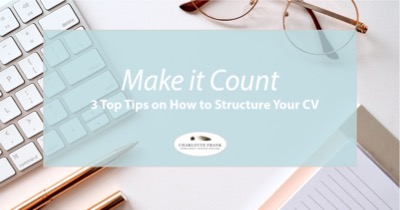Posted on 14/04/2022 by

Market research suggests that when a CV lands in a hiring managers inbox, rather than reviewing the document from back to front, they will “skim read” your CV to decide if they need to investigate further or pass on you as a candidate. Considering the amount of time, thought and preparation that goes into pulling together your ambitions, work history and achievements– that’s not a lot of time to make a positive impression!
Let’s look into the areas of your CV that you should focus on, and how to structure it so you stand out from the crowd.
Style
Be consistent, keep it simple and brief. Your CV should be easy to read and aesthetically look appealing. Use no more than two different font types and follow the same layout and look throughout.
Word has some great free templates that are ready to use, or you can download one from the internet. Another great option if you are looking for more variation on fonts and style is Etsy. For a small fee you can purchase a template and edit as many times as you like.
If you choose to format your own document, be mindful not to make simple formatting mistakes. If you decide to bold a job title, make sure it’s bolded throughout. If you choose to use bullet points, ensure the spacing is always the same. And justify your text. This simple trick will make your document look a lot “cleaner” with the click of a button.
Writing
Spelling mistakes in your CV can almost certainly spell the end when it comes to landing an interview. And don’t just rely on spellcheck to pick up any errors. Read what you wrote to make sure it makes sense. Then read it again. And again. And finally have a friend or family member read it to be sure – when you are working on a document for so long there are bound to be mistakes you miss that someone else can easily pick up!
Structure
The importance of structure in a CV cannot be underestimated – take the time to consider the flow of information. A basic structure includes:
Your details: Make sure your name, phone number, email and LinkedIn are at the top of the page and easy to read and access. Most businesses use LinkedIn in to do their initial research on candidates, so ensure your profile is up to date and you’ve included a link to your personal page.
A brief personal statement: A quick blurb on your previous experience, achievements and any career goals or aspirations you may have.
Work History: Starting with your most recent experience, have a separate section for each of your previous positions. List your title first, then the company name, then the dates you were employed there. Have a short paragraph (1-2 lines) summarizing your experience.
Qualifications and Achievements: Short courses or certificates gained that aren’t relevant to the role you are applying for can be left out, but do includelanguages spoken and availability. Other things you may wish to include if you have the space are any; skills, awards and personal interests or activities you enjoy. Ideally, your CV should be kept to a maximum length of 2 pages.
Whatever information you include in your resume, make sure it is brief and to the point. This is the biggest marketing tool for your personal brand so make sure it counts. And always ensure the information in your CV is relevant to the role you are applying for – you should have multiple versions of your CV by the time you land your new role!!
.jpg)